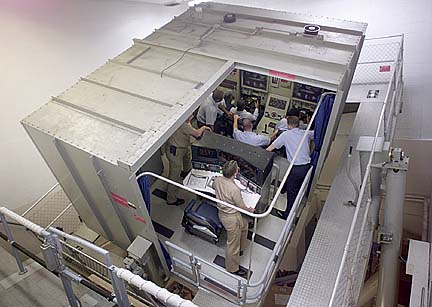


|
Digital sub Standing on the bridge, Lt. j.g. Jesse Balboa barks orders into a microphone as he navigates a 6,000-ton nuclear attack submarine through the Pearl Harbor channel on its way home after a Western Pacific deployment.
simulator sets sail
The Pearl Harbor center
gives sailors vital sea experience
without leaving landBy Gregg K. Kakesako
gkakesako@starbulletin.comTo his left lies Ford Island, and on his right, warships await at anchor near the Pearl Harbor Naval Shipyard.
Using his binoculars, Balboa peers at the rain clouds looming over Aiea Heights. He then trains the binoculars on poles on the Sierra and Yankee docks at Pearl Harbor's submarine base, which he will use to help him guide the ship to its pier.
In reality, Balboa, a 28-year-old junior officer on the USS Olympia, is not standing several stories above the deck of the Los Angeles-class sub. Instead, he is in an air-conditioned classroom on the second floor of Pearl Harbor's Naval Submarine Training Center Pacific in a fiberglass mockup of the bridge of the USS Vesub 2000.
And he is using one of the Navy's newest training tools, a virtual-reality environmental trainer.
"Except for the wind and the sunburn, everything else is there," said Balboa, who was undergoing the training for the first time last week.

|
Wearing a specially rigged helmet and using a special computer program, Balboa is able to view Pearl Harbor as if he were on the bridge of an attack submarine. The view seamlessly changes as he moves his head in any direction, and the computer is programmed to respond to Balboa's voice commands as he navigates through the channel."The whole idea is give the officer the experience of handling a sub on the surface," said Cmdr. Bill Donovan, tactics instructor at the training center of the virtual-reality system that was placed into operation in October. "The whole thing is to trick your eyes into believing that you are at sea."
With a click of a mouse, Balboa's trainer can turn day into night, whip up a storm with waves of up to 30 feet, bring down a rain squall and even cloak Pearl Harbor with a New England fog bank.
The Windows-driven program of digital images even contains a bird's-eye view of Honolulu, Pearl Harbor and other Oahu landmarks.
"In the past," Donovan said, "a junior officer like Balboa would never be able to man the bridge alone. Before, you always had your CO (commanding officer) looking over your shoulder. Now you won't be risking a billion-dollar submarine, and you will get constant feedback as you learn before you actually try to tackle it at sea."
Eventually, Cmdr. Jay Woolston, the training center's executive officer, wants to link the virtual-reality training system to another of the center's training programs that help navigators learn the intricacies of plotting a course while the sub is on the surface.
While Balboa is on the bridge of the sub using landmarks and other navigational aids to help him maneuver, another team of sailors would be below deck plotting the ship's movement on a chart of the harbor.
Using Olympia's periscope, the navigation teams would fix the sub's position on a chart by taking bearings recorded by the periscope.
Petty Officer Cory Lofton, an instructor, said it takes practice to develop the skill to quickly and accurately "shoot these bearings and incorporate the information" on a chart as the ship moves into a harbor, perhaps buffeted by conflicting sea conditions and currents.
In the center's submarine plotting and training room also is a periscope that is linked to computers that project pictures of the approach to the harbors at San Francisco and Bangor, Wash. Using the periscope, the student can take a bearing off navigational aids such as a lighthouse or other buildings used to develop the sub's position as it enters the harbor.
By today's standards the digitized images seen by the periscope may seem crude because they are just two-dimensional and blocklike figures. However, Woolston hopes by next summer to integrate the newer digital technology of the virtual sub.
"That way, the officer of the deck (in the visual-reality trainer) can converse with his navigational team in the next room and work the problem out together," Woolston said.
"Nothing can ever replace going to sea," Woolston added, "but this is as close as you can get."
Another way to give sailors sea experience without getting a submariner's feet wet is a ride in the ship-control trainer, which simulates steering, diving and other submarine movements.
Mounted on a platform, the trainer is the re-creation of part of the control room -- the heart and nerve center of an attack submarine.
Senior Chief Petty Officer Tom Mitchell, combat systems department head, said the hydraulic platform reacts exactly as any sub would, easily mimicking a steep dive or ascent.
"One of the benefits of the trainer," Mitchell added, "is that you can freeze it at any point, discuss what is taking place and review what may be going on wrong and then make the correction right on the spot."
Mitchell said it also gives new, inexperienced submariners a feel on what it is like to drive a submarine before they report on board.
"We can also try things here," Woolston said, "that you would not do with a green team at sea."